|
De Havilland Vampire F.3
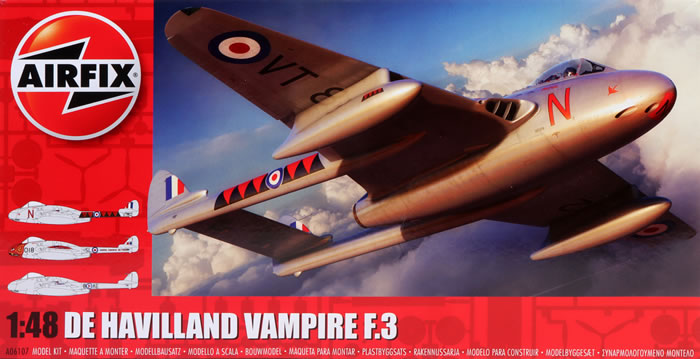
Airfix 1/48 scale
S
u m m a r y |
| Description and Catalogue Number: |
Airfix A06107 - De Havilland Vampire F.3 |
| Scale: |
1/48 |
| Contents and Media: |
118 parts in pale grey injection moulded plastic; eight parts in clear plastic; markings for three aircraft |
| Price: |
£33.99 EU Price (£28.33 Export Price) plus shipping available online from Hannants |
| Review Type: |
FirstLook |
| Advantages: |
High level of detail; crisp and fine surface textures; may be built with undercarriage and flaps up or down; poseable control surfaces; seated pilot figure included; parts also included for FB Mk. 5 although not mentioned in the instructions. |
| Disadvantages: |
Chunky pilot's seat. |
| Conclusion: |
This is a really nice kit with sensible breakdown and a modest number of parts. The quality of the plastic is very good - smooth and ready for a silver finish without any further preparation. Cockpit detail is good, surface textures are fine and there are parts in the box for the FB Mk. 5 too, if you can source your own decals. Airfix's 1/48 scale Vampire F.3 is a nicely detailed but relatively simple kit that should appeal to even less experienced modellers. |
Reviewed by Brett Green

The de Havilland Vampire is a British jet fighter which was developed and manufactured by the de Havilland Aircraft Company. It was the second jet fighter to be operated by the RAF, after the Gloster Meteor, and the first to be powered by one jet engine.
Development of the Vampire as an experimental aircraft began in 1941 during the Second World War, to exploit the revolutionary innovation of jet propulsion. From the company's design studies, it was decided to use a single-engine, twin-boom aircraft, powered by the Halford H.1 turbojet (later produced as the Goblin). Aside from its propulsion system and twin-boom configuration, it was a relatively conventional aircraft. In May 1944 it was decided to produce the aircraft as an interceptor for the Royal Air Force (RAF). In 1946 the Vampire entered operational service with the RAF, only months after the war had ended.
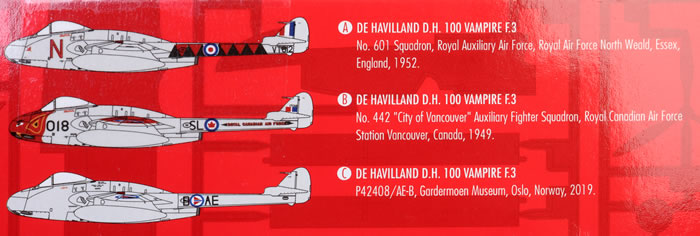
The Vampire quickly proved to be effective and was adopted as a replacement of wartime piston-engined fighter aircraft. During its early service it accomplished several aviation firsts and achieved various records, such as being the first jet aircraft to cross the Atlantic Ocean. The Vampire remained in front-line RAF service until 1953 when its transfer began to secondary roles such as ground attack and pilot training, for which specialist variants were produced. The RAF retired the Vampire in 1966 when its final role of advanced trainer was filled by the Folland Gnat. The Royal Navy had also adapted the type as the Sea Vampire, a navalised variant suitable for operations from aircraft carriers. It was the service's first jet fighter.
The Vampire was exported to many nations and was operated worldwide in numerous theatres and climates. Several countries used the type in combat including the Suez Crisis, the Malayan Emergency and the Rhodesian Bush War. By the end of production, almost 3,300 Vampires had been manufactured, a quarter of these having been manufactured under licence abroad. de Havilland pursued the further development of the type; major derivatives produced include the DH.115, a specialised dual-seat trainer and the more advanced DH.112 Venom, a refined variant for ground attack and night-fighter operations.
This brand new Airfix 1/48 scale de Havilland Vampire F.3 comprises 118 parts in light grey plastic, eight parts in clear and markings for three aircraft.
This is an all-new kit.
Moulding quality is very good. The plastic is smoother than some earlier Airfix releases with no hint of the slightly pebbly finish sometimes found on Airfix's soft plastic. It is a Goldilocks hardness: not too hard and not too soft - just right. I could not find any moulding imperfections in places that would be visible on the finished model..
Surface texture is by way of recessed panel lines. These are fine and quite crisp. They are paired up in a few places with some very fine lines of recessed rivets (the oval-shaped inspection hatches on the booms and on two lower wing panels) . Control surfaces are moulded with a smooth finish.
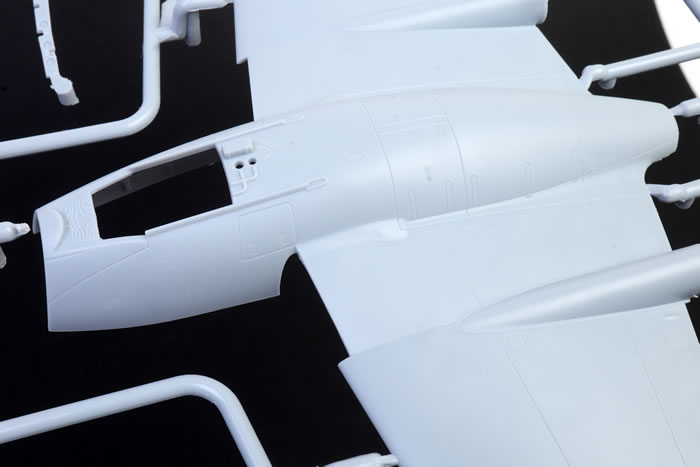
The model may be built with the undercarriage up or down. Alternative parts are included for the opened or closed undercarriage doors.
The interior of the fuselage includes full intake trunking and a nicely depicted fan. The fan is actually the centre section of a wing spar. The undercarriage sidewalls are built up using the wing spar as the forward bulkheads.
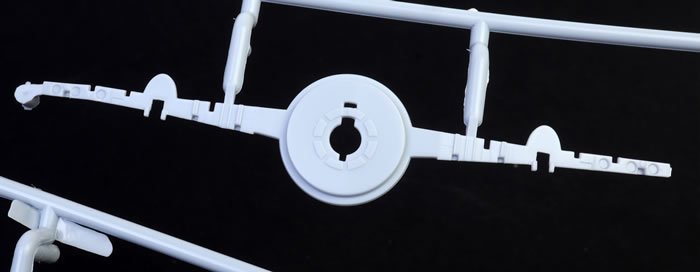
The jet pipe is included too.
The cockpit is simple adequately detailed with the instrument panel, control column, side console, trim wheel and floor. Airfix offers the option of a seat that has moulded harness straps, or a plain seat for the included pilot figure.
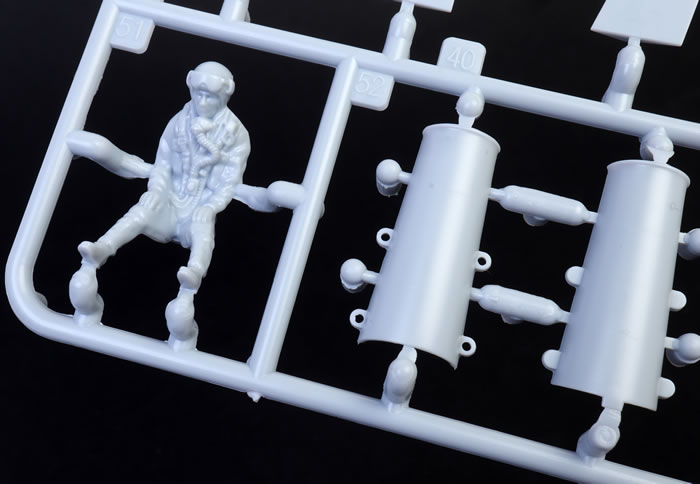
The rudder pedals are moulded onto the floor.
Two instrument panels are supplied - one with dial detail moulded in place (this one is intended to be painted), and one with smooth instrument dials (an overlay instrument panel decal is supplied for this option).
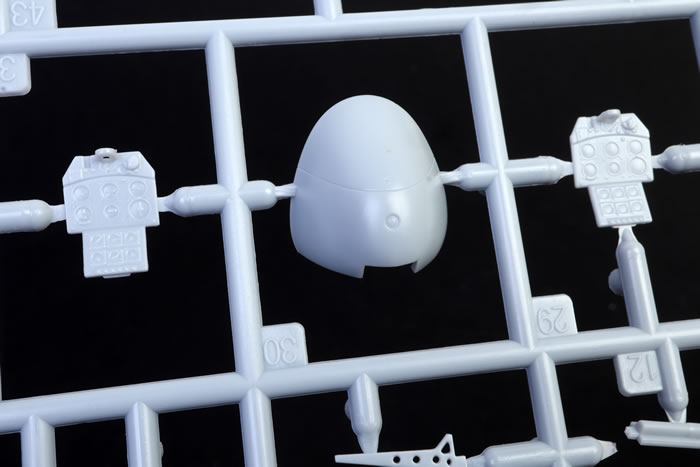
The seats look a bit big and chunky to me, but sanding down the sides and back to a more suitable thinness should fix this issue.
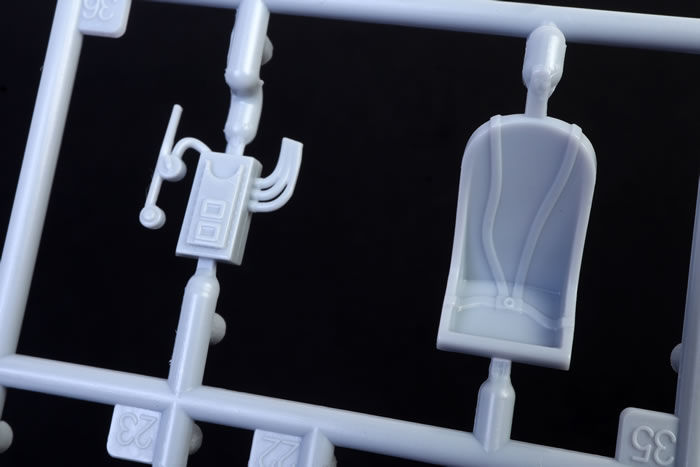
The main airframe is thoughtfully broken down with the upper and lower fuselage pod halves moulded as one piece each with the full span upper and lower wings.
The instructions advise that 17 grams of weight is required for the nose. I will be putting a little bit extra just in case.
The booms are supplied in two pieces each, split lengthwise.
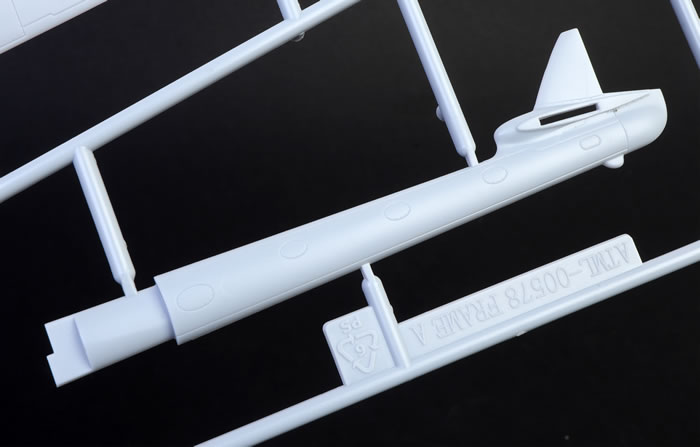
The horizontal stabiliser locks everything into place between the booms. The elevator is a separate part that looks like it should be able to be posed up, down, or neutral. The rudders and ailerons are separate parts too.
The landing flaps are supplied as separate parts and may be posed raised or lowered. Alternative parts are supplied for each option, including additional structural detail, hinges, bottles and actuators for the lowered option.
Main undercarriage legs are moulded as a single piece with a positive locating pin. The complex retraction mechanism for the outer gear doors are moulded as one part per side.
The main and nose wheels are supplied as two parts each. They are subtly flattened and bulged. The axles are keyed to make sure the tyres sit on their flat spots.
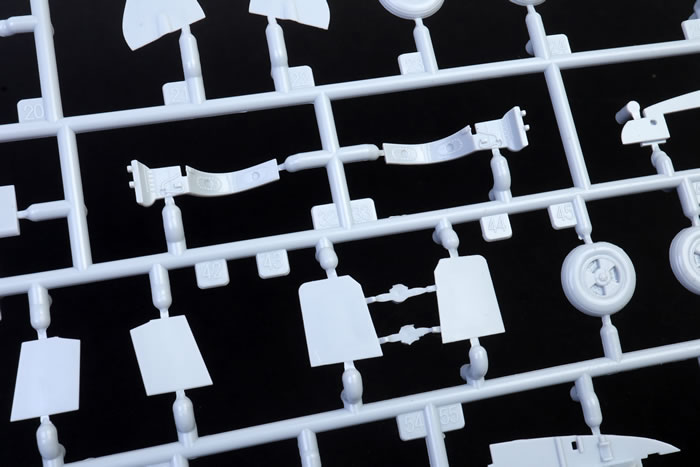
Drop tanks are included.
The canopy is supplied in two pieces. The sliding section may be posed open or closed.
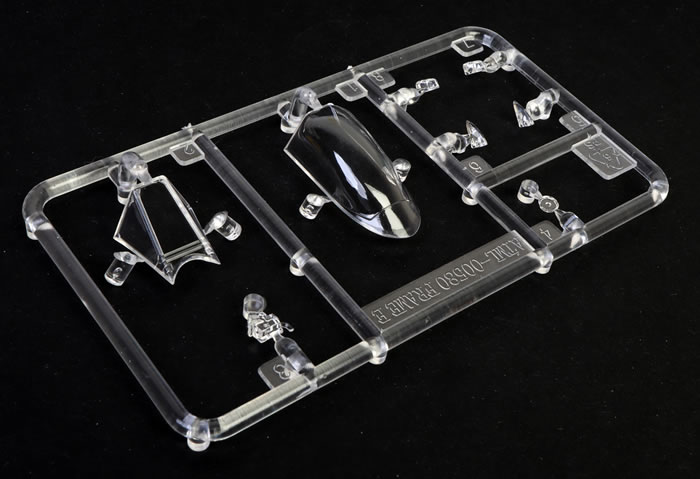
Although they are not mentioned in the instructions, there are parts in the box for the FB Mk. 5 and FB Mk. 9 too.
To make an FB.5, use the clipped wing tips (Parts 15 and 16) alternative undercarriage legs (Parts 27 and 28).
For the tropical FB.9, do the above and also use the port side intake with the longer bullet (Part 37).
You will only have to source your own decals for an FB.5 or an FB.9. Xtradecals' recent sheet no. X48220 offers six colourful FB.5 options.
Thanks to Andrew Robbins for clarifying.
Markings
Three marking options are offered:
-
de Havilland D.H.100 Vampire F.3 VT812/N, No.601 Squadron, Royal Auxiliary Air Force, North Weald, Essex, England 1952
-
de Havilland D.H.100 Vampire F.3 17018, No.442 ‘City of Vancouver’ Auxiliary Fighter Squadron, Royal Canadian Air Force Station Vancouver, Canada, 1949.
-
de Havilland D.H.100 Vampire F.3 P42408/AE-B, Norwegian Air Force, Gardermoen Museum, Oslo, Norway, 2019
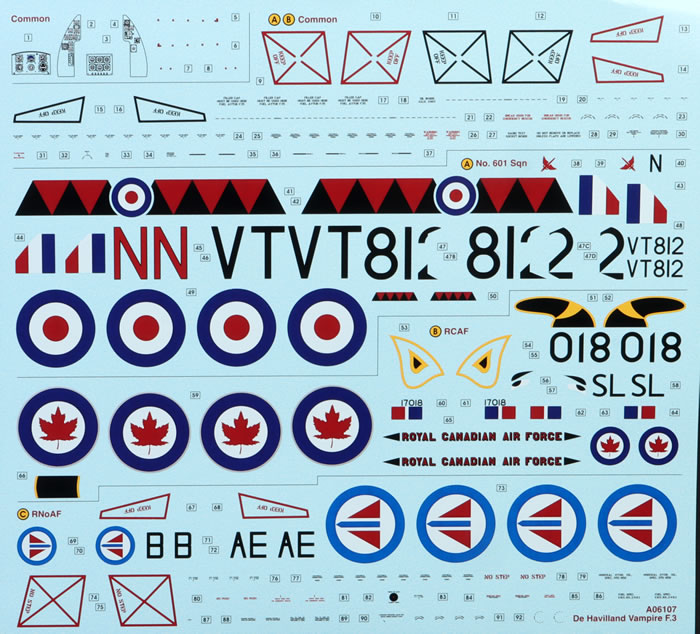
All three options are finished in High Speed Silver painted finish.
The decals feature perfect registration, rich colours and a glossy finish.
Full stencil markings are included.
This is a really nice kit with sensible breakdown and a modest number of parts.
The quality of the plastic is very good - smooth and ready for a silver finish without any further preparation.
Cockpit detail is good, surface textures are fine and there are parts in the box for the FB Mk. 5 too, if you can source your own decals.
Airfix's 1/48 scale Vampire F.3 is a nicely detailed but relatively simple kit that should appeal to even less experienced modellers.
Kit purchased by reviewer from Hannants.
Text and Images Copyright © 2021 by Brett Green
Page Created 17 January, 2022
Last updated
18 January, 2022
Back to HyperScale Main Page |
